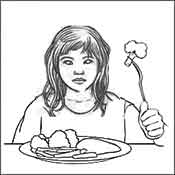Experiences of British Restaurant in WW2 UK

British Restaurants supplied canteen-style, nutritious, basic and cheap off-ration meals to the British public during WW2. This page is from contributors who actually used these restaurants. It explains the prices of meals and describes the token system of payment, the canteen-style service, the food and the restaurant interior and furniture.
____
By the webmaster: her early recollections and further research with contributions from others who lived at the time
The prices of meals
contributed by Gerald Webb
The price of 9 old pennies, i.e. 9d, (4 pence of today's money), is often quoted for the price of a meal in a British Restaurant, but this is not the whole story. The 9d was just for a meat and two veg course, normally with a fish or vegetarian equivalent for the meat. Most people paid a little more for a sweet course and a cup of tea. The 9d was the minimum price which became the standard price, but I think that that the price of the sweet course and cup of tea could vary according to local availability. I seem to remember that in my local British Restaurant in Sussex, the sweet course was 3d and the cup of tea was 2d.
The token system of payment for meals
contributed by Alan Clarke
We queued at the entrance with our old pennies. Then, depending on the state of our wealth that day we were issued with brown, green and, I think, yellow tokens. One was for the main course, one for the 'sweet' and the other for a cup of tea. I think all three cost 10d, but I can't recall ever being in that gourmet range.


British Restaurant meal tokens from Newcastle, courtesy of Malcolm Johnson. He reports that the top ones appear to be of a more brittle type of material than the others and are 3mm thick, whereas the others are 2mm thick.
The material of British Restaurant tokens
contributed by Colin Williamson
The top ones from Newcastle are probably made of Urea Formaldehyde, a thermosetting plastic developed around 1930, which can be in any colour, so is ideally suited for tokens such as these. The bottom ones seem are probably the cheaper alternative of cellulose acetate, which is a development of the earlier Celluloid.

A British Restaurant token, courtesy of David Powell. The V probably stands for vegetarian.
The canteen-style service
contributed by Dick Hibberd
British Restaurants were more like canteens than restaurants. Customers collected a tray and queued up to receive their food - just like in a typical canteen.
contributed by Rob Williams
The amply-built ladies who served us seemed to have had some military training which I understand was with the Women's Voluntary Service (WVS). They wore green overalls. This was at Bury St Edmunds in Suffolk.
contributed by Tony Woods
It was rather like at school dinners.
The food and meals
contributed by Dick Hibberd
In all the British Restaurants that I used or heard about, the food was cooked on site.
contributed by Tony Woods
For the main course, I only recall mashed potato with minced meat and maybe peas. I enjoyed the desserts. There was something like trifle and 'spotted dick' (a stodgy pudding with raisins in it) both served with runny custard. This was at the Edgware British Restaurant.
contributed by John Barton
In Hampstead in the early years of the war, I remember having whale meat in our local British Restaurant. That's what my mother told me it was. It was light in colour and tasted a bit like pork.
contributed by Christine Tolton
All I remember of the British Restaurant in Edgware was the extremely runny custard.
contributed by Dick Hibberd
It was at our local British Restaurant that I discovered something about why we eat food in the order that we do today. Let me explain. One day I was in a hurry when I went to the local British Restaurant. So I got my soup, meat and two veg, and pudding with custard, collected my knife fork and spoons, and went to a table to eat my food. The soup was far too hot, the main course was hot, but the pudding was just right. So I started with the pudding and worked backwards to the soup which was just right temperature by the time I got to it. I felt as sick as a dog afterwards, and have never been tempted to repeat the experience again. Obviously we eat food in the order we do for very good reasons.
The restaurant interior and furnishings
All the British restaurant interiors were basic but by their very nature, they were different from one another across the country.
contributed by Rob Williams
We sat on long wooden benches at tables covered in American cloth.
contributed by Tony Woods
The fold-up tables and benches were wobbly, but there were table cloths. These were made of American cloth, and they had check pattern which reminded me of a draught board. This was in the Edgware British Restaurant.
| sources | webmaster | contact |
Text and images are copyright
If you can add anything to this page or provide a photo, please contact me.



